TAM IV is a unique Microcalorimeter system that is completely modular and combines the highest heat flow sensitivity with unmatched long term temperature stability for measuring many processes that are undetectable by other techniques.
Sales Promotions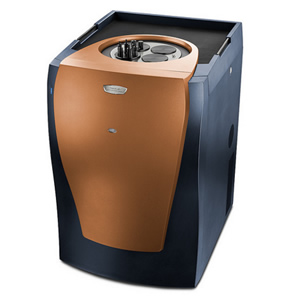
All chemical, physical and biological processes are associated with a heat production or heat consumption. TAM IV is the most sensitive, stable and flexible microcalorimeter system in the world for directly measuring this universal heat signal and, therefore, the quantitative thermodynamic and kinetic observation of any process. It is a unique microcalorimeter system that is completely modular and combines the highest heat flow sensitivity with unmatched long term temperature stability for measuring many processes that are undetectable by other techniques. A wide range of calorimeter configurations and sample handling systems provide maximum application flexibility and ensure optimum laboratory productivity.
Features & Benefits
- New and more responsive temperature control provides rapid thermal equilibration and extended temperature range of 4 °C to 150 °C for real-world cold storage applications.
- Unmatched temperature stability for accurate heat flow measurement in experiments that last anywhere from a few hours to days and weeks
- Four calorimeter positions that can be equipped with up to four calorimeters, each of which operates simultaneously and independently
- Calorimeters are available in a wide variety of configurations: size, sensitivity, throughput, and ancillary sample measurement or manipulation capabilities
- New Accessory Interface box with capacity for up to eight separate accessories for unmatched flexibility
- New voltage I/O module for interfacing up to three independent probes/sources, such as pH probe or light source
- New Accessory Interface box with capacity for up to eight modules
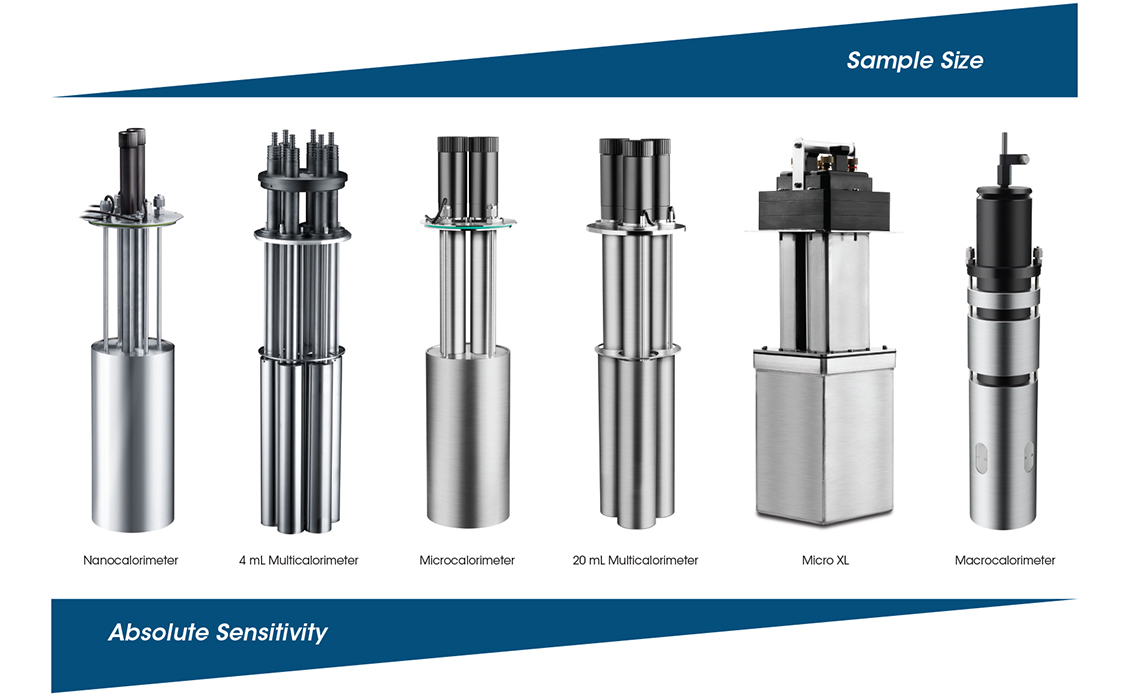
Nanocalorimeter
 Nanocalorimeter
Nanocalorimeter
The Nanocalorimeter is the most sensitive calorimeter for the TAM IV, and is typically used in the isothermal mode. It combines high sensitivity with excellent baseline stability which makes it ideal for isothermal titration calorimetry (ITC) in studying molecular interactions. The nanocalorimeter holds all closed ampoules up to 4 ml. For highest sensitivity it is used with the 1 ml titration ampoule and a similar ampoule as reference. This reference ampoule contains an inert substance, (e.g. water or sand) in order to balance the heat capacity of the two sides. Thus, under normal conditions the heat flow associated with the reference ampoule will be negligible.
Microcalorimeter
Microcalorimeter
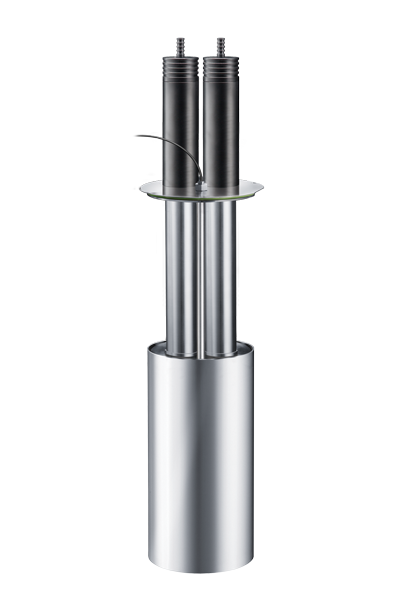 The 20 ml Microcalorimeter is a heat flow calorimeter of twin type. It has been designed to hold large samples, (e.g. batteries) and for experiments requiring a large gas phase above the sample. The microcalorimeter can be used with all 20 ml static ampoules and the 20 ml micro reaction system including titration facilities and control of the relative humidity during measurement.
The 20 ml Microcalorimeter is a heat flow calorimeter of twin type. It has been designed to hold large samples, (e.g. batteries) and for experiments requiring a large gas phase above the sample. The microcalorimeter can be used with all 20 ml static ampoules and the 20 ml micro reaction system including titration facilities and control of the relative humidity during measurement.
The 20ml Microcalorimeter is also the only calorimeter that can be used with the micro solution ampoule. This ampoule is designed for dissolution of very small amounts of solids (a few mg) in different solvents and is ideal for dissolution of slowly soluble substances. The heat of dissolution and the kinetics of dissolution can be studied.
Minicalorimeter
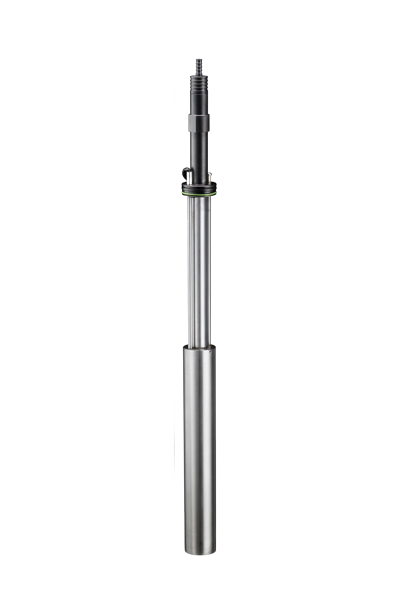 Minicalorimeter
Minicalorimeter
The Minicalorimeter is a 4 mL or 20mL calorimeter with a special design to reduce the space occupied by the calorimeter inside the thermostat. The reference is positioned below the sample ampoule which up to 48 4 mL Minicalorimeters can be positioned in the TAM IV-48 thermostat. The Minicalorimeter is also used in the Multicalorimeter where six 4 mL minicalorimeters and three 20 mL calorimeters are assembled together and each assembly occupies one position in the TAM IV thermostat. It has been designed for increased sample throughput.
Multicalorimeter
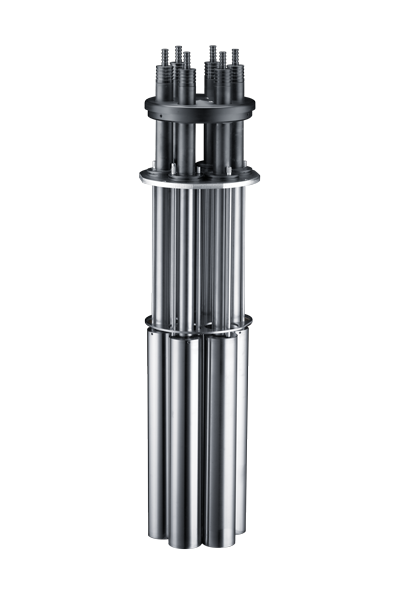 Multicalorimeter
Multicalorimeter
 The TAM Multicalorimeter contains six 4 mL Minicalorimeters or three 20 mL Minicalorimeters. They are intended for use with the TAM IV thermostat to increase the sample throughput. The TAM IV thermostat can hold up to 24 individual 4 mL calorimeters and twelve 20 mL calorimeters, as well as other types of calorimeters such as a Nanocalorimeter or a Precision Solution Calorimeter. These combinations offer the highest flexibility by combining high sensitivity with high sample throughput. It can be used for all applications designed for individual Minicalorimeters.
The TAM Multicalorimeter contains six 4 mL Minicalorimeters or three 20 mL Minicalorimeters. They are intended for use with the TAM IV thermostat to increase the sample throughput. The TAM IV thermostat can hold up to 24 individual 4 mL calorimeters and twelve 20 mL calorimeters, as well as other types of calorimeters such as a Nanocalorimeter or a Precision Solution Calorimeter. These combinations offer the highest flexibility by combining high sensitivity with high sample throughput. It can be used for all applications designed for individual Minicalorimeters.
Macrocalorimeter
 Macrocalorimeter
Macrocalorimeter
The Macrocalorimeter is a large volume calorimeter designed for accurate heat flow measurements of samples requiring volumes up to 125 mL. The Macrocalorimeter is of minicalorimeter design with sample above reference, but with a user-changeable reference for optimal performance. The Macrocalorimeter is suitable for battery testing but also for large and heterogeneous sample within food technology and ecological sciences.
Precision Solution Calorimetry
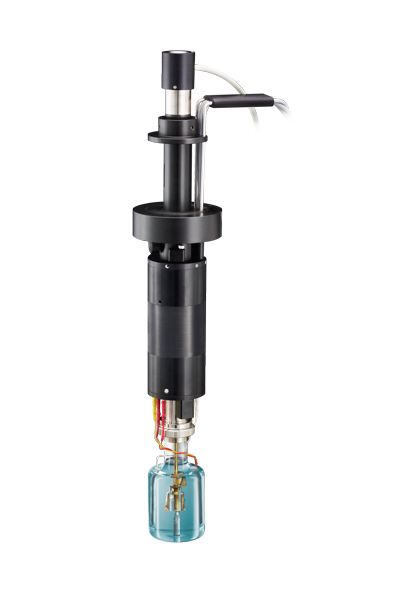 Precision Solution Calorimetry
Precision Solution Calorimetry
Solution Calorimetry refers to the determination of the heat of dissolution when a solid is dissolved in a liquid, or two liquids are mixed. The TAM Precision Solution Calorimeter is a single position, semi-adiabatic calorimeter for high precision measurements of the heat generated or consumed when a solid or liquid sample is dissolved or diluted into a solvent. The instrument is designed for highest accuracy and precision and is used in general thermodynamic investigations as well as for quantitative analytical measurements of various solid state phases. It is available with a 25 ml or 100 ml vessel, and is intended for use with the TAM IV thermostat up to 80 °C.
Precision Titration Calorimeter
The Precision Titration Calorimeter is a single position, semi-adiabatic calorimeter intended for use with the TAM IV Thermostat. It provides high precision measurements of the heat generated or consumed when a solid or liquid sample is dissolved or diluted into a solvent. Utilizing the same configuration as the Precision Solution Calorimeter but with additional functionality, it is possible to inject small quantities of a solute into the stirred solution in order to investigate binding or complexation phenomena. Repeated injections can be performed by use of a syringe pump.
The Precision Titration Calorimeter is designed for highest accuracy and precision and is used in general thermodynamic investigations as well as for quantitative analytical measurements of various solid state phases.
Isothermal Titration Calorimetry
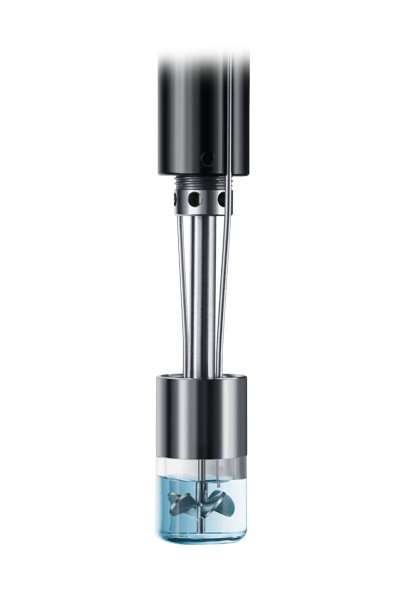 Isothermal Titration Calorimetry
Isothermal Titration Calorimetry
Isothermal Titration Calorimetry (ITC) is a powerful analytical technique for characterizing a wide range of molecular interactions as well as enzyme and chemical kinetics. The ITC reaction systems can be used for injecting one sample into another, such as creating a bioassay for the study of cell metabolism when a drug is injected into a living cell culture. The removable ampoule design of the TAM ITC system provides maximum flexibility to accommodate a wide variety of ITC applications.
The TAM Isothermal Titration Calorimetry (TAM-ITC) system consists of a nanocalorimeter, 1 ml removable titration ampoule with stirring facilities, and a precision syringe pump for efficient titrant delivery. The TA Instruments nanocalorimeter is the most sensitive calorimeter available for the TAM IV, and can detect microjoule level heat flow. In dynamically corrected mode, the response time of the calorimeter is optimized.
Micro XL Calorimeter
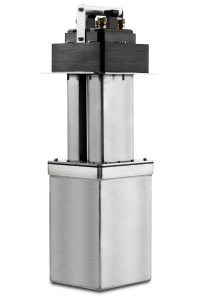
Micro XL Calorimeter
The TAM IV Micro XL is a large-cell, precision calorimeter that was specifically designed to aid researchers in measuring the electrochemical reactions occurring inside of battery cells. Characterizing these reactions is critical to developing a safer battery with longer shelf life and higher energy density. The TAM IV Micro XL compliments the existing range of calorimeters for the TAM IV thermostat, and in combination with other calorimeters will aid development of advanced battery technologies.
TAM Ampoules
TAM Ampoules are used to contain the sample in the calorimeter during measurement. The ampoules are of two basic types; Closed and Open. In the Closed ampoules, no manipulation to the sample is done during the measurement. In the Open ampoules, also referred to as the Micro Reaction System, the sample can be manipulated after insertion into the calorimeter.
- Closed Ampoules – A majority of experiments do not need any change in the experimental conditions during measurements. Such experiments can be run in closed ampoules.
- Open Ampoules – The Micro Reaction System is used whenever sample manipulation is required during measurements. With the Micro Reaction System gas or liquid can be perfused over a sample, injections of one substance to another stirred substance can be made, or the sample can be exposed to a controlled relative humidity or vapor pressure. The sample is loaded into a reaction vessel made of glass, stainless steel or hastelloy. This reaction vessel (available in 1, 4, 20ml) is then sealed on the Micro Reaction ampoule.
Closed Ampoules
Closed Ampoules
Disposable Crimp Seal Glass Ampoules
Disposable ampoules are the most convenient to use since they can be thrown away after use and no cleaning is required. The crimp seal ampoule is perfect for experiments at lower temperature ranges. They are available in 3, 4 and 20 ml sizes.
Stainless Steel Ampoules
Available in regular stainless steel or hastelloy, these ampoules are used for samples that either react with glass, are to be investigated at high temperatures, or where it is suspected that a gas will be evolved during the experiment which increases the pressure in the ampoule. Ampoule lids are screw top and are available in 4 and 20 ml sizes.
Heat Sealed Ampoules
The heat seal ampoules are sealed by melting the glass at the top of the ampoule. These are recommended when rubber caps would be affected by gases or liquid involved in a reaction. The reactants are completely surrounded by glass. They are available for a maximum sample volume of 5 ml.
Titration Ampoule
 Titration Ampoule
Titration Ampoule
The removable ampoules offer a level of practicality unmatched in the industry. TAM-ITC ampoules are easily removed, can be visually inspected and cleaned outside of the instrument. The open vessels of TAM-ITC ampoules also allows solid suspensions, solid matrixes with attached living cells, macromolecules, etc. to be loaded into the reaction vessel. This allows ligand binding to the solid system to be measured. There is no possibility for this kind of matrix experiments to be run on fixed-cell instruments.
In TAM-ITC different sizes of syringes ranging from 100 to 2.5 mL are available. The injection volume/flow is controlled by a high precision syringe pump. Each pump can support two syringes. In addition, two pumps can be attached to one titration ampoule which is useful for studying enzyme kinetics.
Perfusion Ampoule
 Perfusion Ampoule
Perfusion Ampoule
The perfusion ampoule is the simplest micro reaction system available, and is typically used with the Nanocalorimeter. A liquid or gas is perfused through the ampoule and out through an exit tube. Gases are perfused using a mass flow controller that is controlled by TAM Assistant™s software. Liquids are perfused using a peristaltic pump. The perfusion ampoule can be used to measure either the heat production rate from a flowing gas/liquid or the effect of the gas/liquid on a sample placed in the perfusion ampoule. The perfusion ampoule is available in 1, 4 and 20 ml versions.
RH Perfusion Ampoule
 RH Perfusion Ampoule
RH Perfusion Ampoule
The RH perfusion ampoule perfuses a gas of defined relative humidity over a sample and out through an exit tube. The relative humidity is controlled using two mass flow controllers, one of which passes gas directly to the sample and the other passes gas through two humidifying chambers prior to the sample. TAM Assistant™ software controls both the relative humidity and the total flow rate over the sample. The software is also used to change the humidity in a linear ramp or stepwise. The RH perfusion ampoule is available in 1, 4 and 20 ml versions. It is possible to use solvents other than water in the humidifying chambers which allows a gas of varying vapor pressure of a solvent to be passed over a sample.
Vacuum/Pressure Ampoule
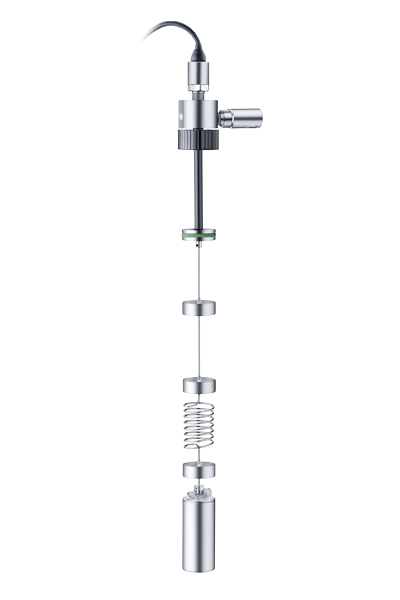 Vacuum/Pressure Ampoule
Vacuum/Pressure Ampoule
These stainless steel ampoules are designed to hold vacuum or pressure up to 10 bar. The pressure in the ampoule can be monitored at the same time heat flow is measured. This is ideal for the study of samples generating gaseous products during a reaction. The ampoule is available in 4 and 20 ml sizes.
Accessories
All accessories are fully integrated with TAM Assistant software.
- I/O Accessory
Enables additional signal input and measurements with three external devices. - Gas Flow Control Kit
Provides precise control of gases during perfusion or RH perfusion experiments. - Syringe Pump
Dual syringe pump provides precise control of injection volume, interval and speed during Isothermal Titration Calorimetry experiments. - Liquid Flow Control
Dual peristaltic pumps provide efficient delivery and mixing of liquids.
The versatility of the TAM system provides for a common platform through which to perform a wide variety of calorimetric experiments.
Isothermal Calorimetry
ISOTHERMAL CALORIMETRY
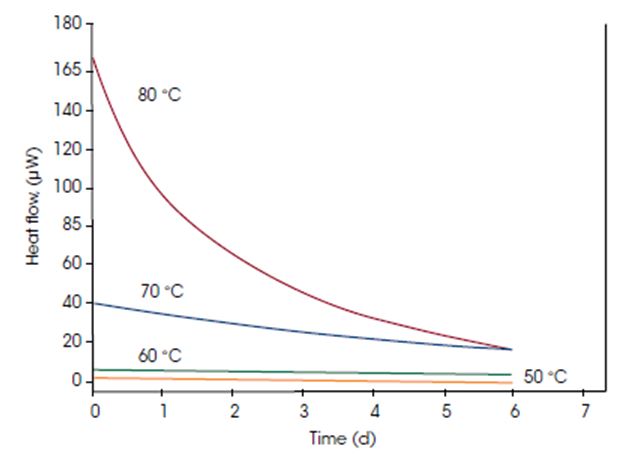
The most common experimental mode for microcalorimetry is the isothermal mode, where the sample is held at a constant temperature while the heat produced or consumed by the sample is measured. Both short- and long-term measurements (hours to weeks) can be performed with exceptional stability and reliability. The example shows how the reaction rate increases with increased temperature.
Scanning Calorimetry
SCANNING CALORIMETRY
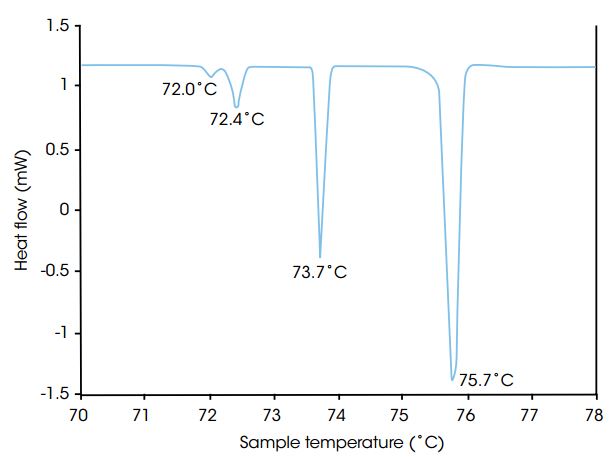
The sample is ramped slowly up and/or down in temperature while the heat produced or consumed by the sample is measured. Experiments performed under extremely slow (maximum 2 °C/h) and well controlled scanning conditions provides greater resolution of phase transitions compared to conventional DSC instruments. The slow scan rate allows large samples to be analyzed close to thermal, physical and chemical equilibrium
The example show a slow scanning experiment resolving four endothermic transitions of n-hexatriacontane
Isothermal Titration Calorimetry
ISOTHERMAL TITRATION CALORIMETRY
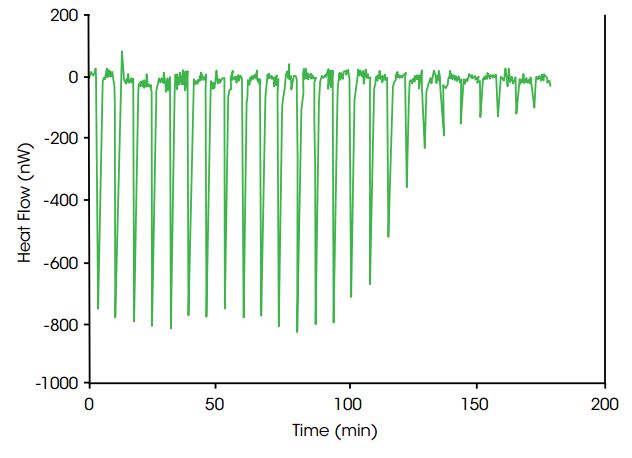
Isothermal Titration Calorimetry (ITC) is a powerful analytical technique for characterizing a wide range of molecular interactions as well as enzyme and chemical kinetics. The example shows a ligand that is injected repeatedly into a target molecule. From the heat injection binding affinity, stoichiometry and enthalpy of interaction can be determined.
Solution Calorimetry
SOLUTION CALORIMETRY
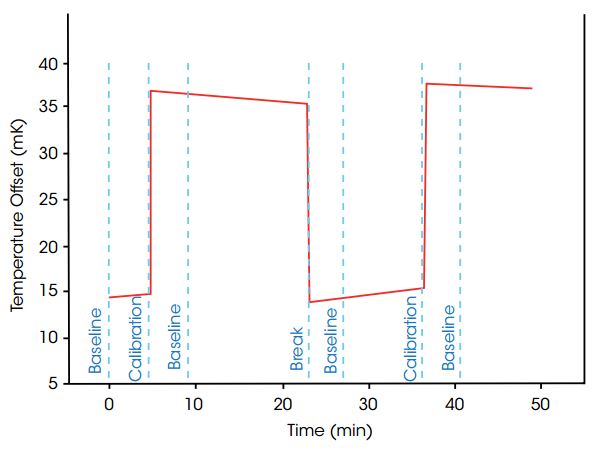
Solution calorimetry is a powerful technique for characterizing heat transfer between molecules and understanding dissolution phenomena. The most common measurement is semi-adiabatic, where the temperature increase or decrease in a solution is measured during a solid or liquid dissolution process.
- Description
-
All chemical, physical and biological processes are associated with a heat production or heat consumption. TAM IV is the most sensitive, stable and flexible microcalorimeter system in the world for directly measuring this universal heat signal and, therefore, the quantitative thermodynamic and kinetic observation of any process. It is a unique microcalorimeter system that is completely modular and combines the highest heat flow sensitivity with unmatched long term temperature stability for measuring many processes that are undetectable by other techniques. A wide range of calorimeter configurations and sample handling systems provide maximum application flexibility and ensure optimum laboratory productivity.
- Features
-
Features & Benefits
- New and more responsive temperature control provides rapid thermal equilibration and extended temperature range of 4 °C to 150 °C for real-world cold storage applications.
- Unmatched temperature stability for accurate heat flow measurement in experiments that last anywhere from a few hours to days and weeks
- Four calorimeter positions that can be equipped with up to four calorimeters, each of which operates simultaneously and independently
- Calorimeters are available in a wide variety of configurations: size, sensitivity, throughput, and ancillary sample measurement or manipulation capabilities
- New Accessory Interface box with capacity for up to eight separate accessories for unmatched flexibility
- New voltage I/O module for interfacing up to three independent probes/sources, such as pH probe or light source
- New Accessory Interface box with capacity for up to eight modules
- Calorimeters
-

Nanocalorimeter
 Nanocalorimeter
NanocalorimeterThe Nanocalorimeter is the most sensitive calorimeter for the TAM IV, and is typically used in the isothermal mode. It combines high sensitivity with excellent baseline stability which makes it ideal for isothermal titration calorimetry (ITC) in studying molecular interactions. The nanocalorimeter holds all closed ampoules up to 4 ml. For highest sensitivity it is used with the 1 ml titration ampoule and a similar ampoule as reference. This reference ampoule contains an inert substance, (e.g. water or sand) in order to balance the heat capacity of the two sides. Thus, under normal conditions the heat flow associated with the reference ampoule will be negligible.
Microcalorimeter
Microcalorimeter
 The 20 ml Microcalorimeter is a heat flow calorimeter of twin type. It has been designed to hold large samples, (e.g. batteries) and for experiments requiring a large gas phase above the sample. The microcalorimeter can be used with all 20 ml static ampoules and the 20 ml micro reaction system including titration facilities and control of the relative humidity during measurement.
The 20 ml Microcalorimeter is a heat flow calorimeter of twin type. It has been designed to hold large samples, (e.g. batteries) and for experiments requiring a large gas phase above the sample. The microcalorimeter can be used with all 20 ml static ampoules and the 20 ml micro reaction system including titration facilities and control of the relative humidity during measurement.The 20ml Microcalorimeter is also the only calorimeter that can be used with the micro solution ampoule. This ampoule is designed for dissolution of very small amounts of solids (a few mg) in different solvents and is ideal for dissolution of slowly soluble substances. The heat of dissolution and the kinetics of dissolution can be studied.
Minicalorimeter
 Minicalorimeter
MinicalorimeterThe Minicalorimeter is a 4 mL or 20mL calorimeter with a special design to reduce the space occupied by the calorimeter inside the thermostat. The reference is positioned below the sample ampoule which up to 48 4 mL Minicalorimeters can be positioned in the TAM IV-48 thermostat. The Minicalorimeter is also used in the Multicalorimeter where six 4 mL minicalorimeters and three 20 mL calorimeters are assembled together and each assembly occupies one position in the TAM IV thermostat. It has been designed for increased sample throughput.
Multicalorimeter
 Multicalorimeter
Multicalorimeter The TAM Multicalorimeter contains six 4 mL Minicalorimeters or three 20 mL Minicalorimeters. They are intended for use with the TAM IV thermostat to increase the sample throughput. The TAM IV thermostat can hold up to 24 individual 4 mL calorimeters and twelve 20 mL calorimeters, as well as other types of calorimeters such as a Nanocalorimeter or a Precision Solution Calorimeter. These combinations offer the highest flexibility by combining high sensitivity with high sample throughput. It can be used for all applications designed for individual Minicalorimeters.
The TAM Multicalorimeter contains six 4 mL Minicalorimeters or three 20 mL Minicalorimeters. They are intended for use with the TAM IV thermostat to increase the sample throughput. The TAM IV thermostat can hold up to 24 individual 4 mL calorimeters and twelve 20 mL calorimeters, as well as other types of calorimeters such as a Nanocalorimeter or a Precision Solution Calorimeter. These combinations offer the highest flexibility by combining high sensitivity with high sample throughput. It can be used for all applications designed for individual Minicalorimeters.Macrocalorimeter
 Macrocalorimeter
Macrocalorimeter
The Macrocalorimeter is a large volume calorimeter designed for accurate heat flow measurements of samples requiring volumes up to 125 mL. The Macrocalorimeter is of minicalorimeter design with sample above reference, but with a user-changeable reference for optimal performance. The Macrocalorimeter is suitable for battery testing but also for large and heterogeneous sample within food technology and ecological sciences.
Precision Solution Calorimetry
 Precision Solution Calorimetry
Precision Solution Calorimetry
Solution Calorimetry refers to the determination of the heat of dissolution when a solid is dissolved in a liquid, or two liquids are mixed. The TAM Precision Solution Calorimeter is a single position, semi-adiabatic calorimeter for high precision measurements of the heat generated or consumed when a solid or liquid sample is dissolved or diluted into a solvent. The instrument is designed for highest accuracy and precision and is used in general thermodynamic investigations as well as for quantitative analytical measurements of various solid state phases. It is available with a 25 ml or 100 ml vessel, and is intended for use with the TAM IV thermostat up to 80 °C.Precision Titration Calorimeter
The Precision Titration Calorimeter is a single position, semi-adiabatic calorimeter intended for use with the TAM IV Thermostat. It provides high precision measurements of the heat generated or consumed when a solid or liquid sample is dissolved or diluted into a solvent. Utilizing the same configuration as the Precision Solution Calorimeter but with additional functionality, it is possible to inject small quantities of a solute into the stirred solution in order to investigate binding or complexation phenomena. Repeated injections can be performed by use of a syringe pump.The Precision Titration Calorimeter is designed for highest accuracy and precision and is used in general thermodynamic investigations as well as for quantitative analytical measurements of various solid state phases.
Isothermal Titration Calorimetry
 Isothermal Titration Calorimetry
Isothermal Titration CalorimetryIsothermal Titration Calorimetry (ITC) is a powerful analytical technique for characterizing a wide range of molecular interactions as well as enzyme and chemical kinetics. The ITC reaction systems can be used for injecting one sample into another, such as creating a bioassay for the study of cell metabolism when a drug is injected into a living cell culture. The removable ampoule design of the TAM ITC system provides maximum flexibility to accommodate a wide variety of ITC applications.
The TAM Isothermal Titration Calorimetry (TAM-ITC) system consists of a nanocalorimeter, 1 ml removable titration ampoule with stirring facilities, and a precision syringe pump for efficient titrant delivery. The TA Instruments nanocalorimeter is the most sensitive calorimeter available for the TAM IV, and can detect microjoule level heat flow. In dynamically corrected mode, the response time of the calorimeter is optimized.
Micro XL Calorimeter

Micro XL Calorimeter
The TAM IV Micro XL is a large-cell, precision calorimeter that was specifically designed to aid researchers in measuring the electrochemical reactions occurring inside of battery cells. Characterizing these reactions is critical to developing a safer battery with longer shelf life and higher energy density. The TAM IV Micro XL compliments the existing range of calorimeters for the TAM IV thermostat, and in combination with other calorimeters will aid development of advanced battery technologies.
- Ampoules
-
TAM Ampoules
TAM Ampoules are used to contain the sample in the calorimeter during measurement. The ampoules are of two basic types; Closed and Open. In the Closed ampoules, no manipulation to the sample is done during the measurement. In the Open ampoules, also referred to as the Micro Reaction System, the sample can be manipulated after insertion into the calorimeter.
- Closed Ampoules – A majority of experiments do not need any change in the experimental conditions during measurements. Such experiments can be run in closed ampoules.
- Open Ampoules – The Micro Reaction System is used whenever sample manipulation is required during measurements. With the Micro Reaction System gas or liquid can be perfused over a sample, injections of one substance to another stirred substance can be made, or the sample can be exposed to a controlled relative humidity or vapor pressure. The sample is loaded into a reaction vessel made of glass, stainless steel or hastelloy. This reaction vessel (available in 1, 4, 20ml) is then sealed on the Micro Reaction ampoule.
Closed Ampoules
Closed Ampoules
Disposable Crimp Seal Glass Ampoules
Disposable ampoules are the most convenient to use since they can be thrown away after use and no cleaning is required. The crimp seal ampoule is perfect for experiments at lower temperature ranges. They are available in 3, 4 and 20 ml sizes.
Stainless Steel Ampoules
Available in regular stainless steel or hastelloy, these ampoules are used for samples that either react with glass, are to be investigated at high temperatures, or where it is suspected that a gas will be evolved during the experiment which increases the pressure in the ampoule. Ampoule lids are screw top and are available in 4 and 20 ml sizes.
Heat Sealed Ampoules
The heat seal ampoules are sealed by melting the glass at the top of the ampoule. These are recommended when rubber caps would be affected by gases or liquid involved in a reaction. The reactants are completely surrounded by glass. They are available for a maximum sample volume of 5 ml.
Titration Ampoule
 Titration Ampoule
Titration AmpouleThe removable ampoules offer a level of practicality unmatched in the industry. TAM-ITC ampoules are easily removed, can be visually inspected and cleaned outside of the instrument. The open vessels of TAM-ITC ampoules also allows solid suspensions, solid matrixes with attached living cells, macromolecules, etc. to be loaded into the reaction vessel. This allows ligand binding to the solid system to be measured. There is no possibility for this kind of matrix experiments to be run on fixed-cell instruments.
In TAM-ITC different sizes of syringes ranging from 100 to 2.5 mL are available. The injection volume/flow is controlled by a high precision syringe pump. Each pump can support two syringes. In addition, two pumps can be attached to one titration ampoule which is useful for studying enzyme kinetics.
Perfusion Ampoule
 Perfusion Ampoule
Perfusion Ampoule
The perfusion ampoule is the simplest micro reaction system available, and is typically used with the Nanocalorimeter. A liquid or gas is perfused through the ampoule and out through an exit tube. Gases are perfused using a mass flow controller that is controlled by TAM Assistant™s software. Liquids are perfused using a peristaltic pump. The perfusion ampoule can be used to measure either the heat production rate from a flowing gas/liquid or the effect of the gas/liquid on a sample placed in the perfusion ampoule. The perfusion ampoule is available in 1, 4 and 20 ml versions.
RH Perfusion Ampoule
 RH Perfusion Ampoule
RH Perfusion AmpouleThe RH perfusion ampoule perfuses a gas of defined relative humidity over a sample and out through an exit tube. The relative humidity is controlled using two mass flow controllers, one of which passes gas directly to the sample and the other passes gas through two humidifying chambers prior to the sample. TAM Assistant™ software controls both the relative humidity and the total flow rate over the sample. The software is also used to change the humidity in a linear ramp or stepwise. The RH perfusion ampoule is available in 1, 4 and 20 ml versions. It is possible to use solvents other than water in the humidifying chambers which allows a gas of varying vapor pressure of a solvent to be passed over a sample.
Vacuum/Pressure Ampoule
 Vacuum/Pressure Ampoule
Vacuum/Pressure AmpouleThese stainless steel ampoules are designed to hold vacuum or pressure up to 10 bar. The pressure in the ampoule can be monitored at the same time heat flow is measured. This is ideal for the study of samples generating gaseous products during a reaction. The ampoule is available in 4 and 20 ml sizes.
- Accessories
-
Accessories
All accessories are fully integrated with TAM Assistant software.
- I/O Accessory
Enables additional signal input and measurements with three external devices. - Gas Flow Control Kit
Provides precise control of gases during perfusion or RH perfusion experiments. - Syringe Pump
Dual syringe pump provides precise control of injection volume, interval and speed during Isothermal Titration Calorimetry experiments. - Liquid Flow Control
Dual peristaltic pumps provide efficient delivery and mixing of liquids.
- I/O Accessory
- Experiments
-
The versatility of the TAM system provides for a common platform through which to perform a wide variety of calorimetric experiments.
Isothermal Calorimetry
ISOTHERMAL CALORIMETRY

The most common experimental mode for microcalorimetry is the isothermal mode, where the sample is held at a constant temperature while the heat produced or consumed by the sample is measured. Both short- and long-term measurements (hours to weeks) can be performed with exceptional stability and reliability. The example shows how the reaction rate increases with increased temperature.
Scanning Calorimetry
SCANNING CALORIMETRY

The sample is ramped slowly up and/or down in temperature while the heat produced or consumed by the sample is measured. Experiments performed under extremely slow (maximum 2 °C/h) and well controlled scanning conditions provides greater resolution of phase transitions compared to conventional DSC instruments. The slow scan rate allows large samples to be analyzed close to thermal, physical and chemical equilibrium
The example show a slow scanning experiment resolving four endothermic transitions of n-hexatriacontane
Isothermal Titration Calorimetry
ISOTHERMAL TITRATION CALORIMETRY

Isothermal Titration Calorimetry (ITC) is a powerful analytical technique for characterizing a wide range of molecular interactions as well as enzyme and chemical kinetics. The example shows a ligand that is injected repeatedly into a target molecule. From the heat injection binding affinity, stoichiometry and enthalpy of interaction can be determined.
Solution Calorimetry
SOLUTION CALORIMETRY

Solution calorimetry is a powerful technique for characterizing heat transfer between molecules and understanding dissolution phenomena. The most common measurement is semi-adiabatic, where the temperature increase or decrease in a solution is measured during a solid or liquid dissolution process.
- Resources











